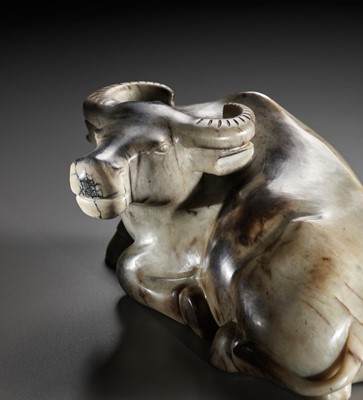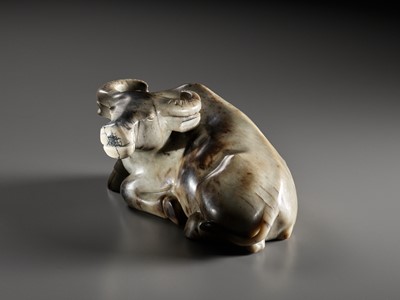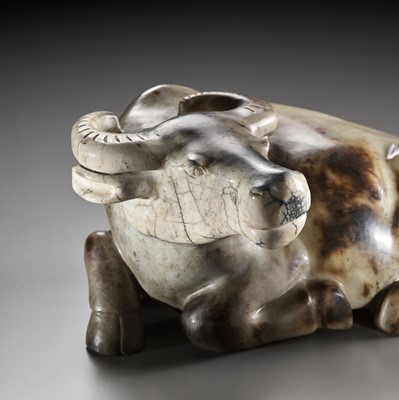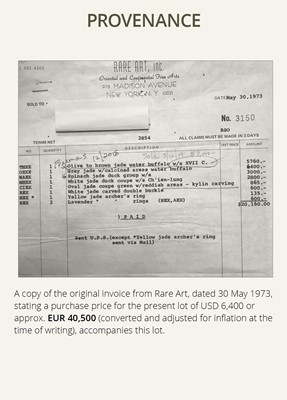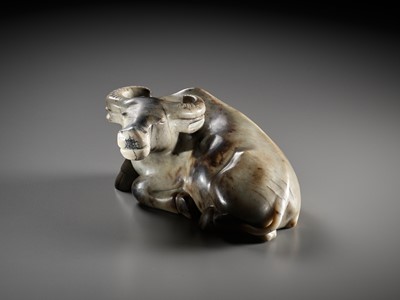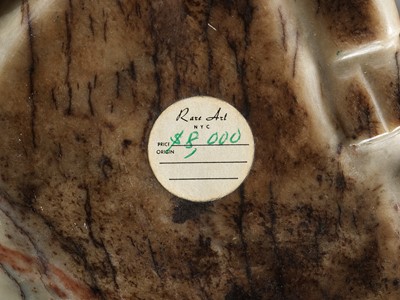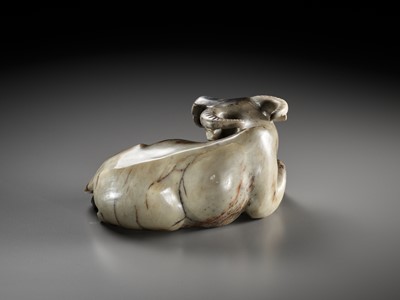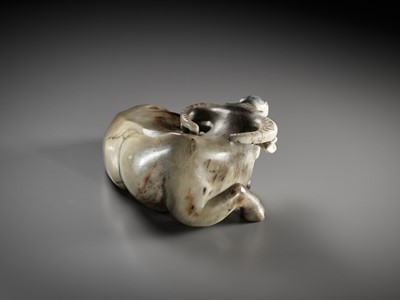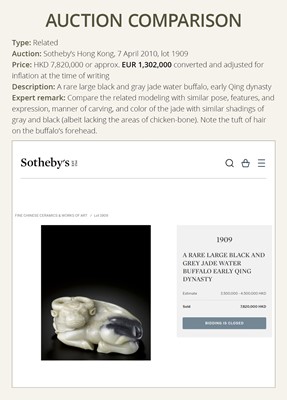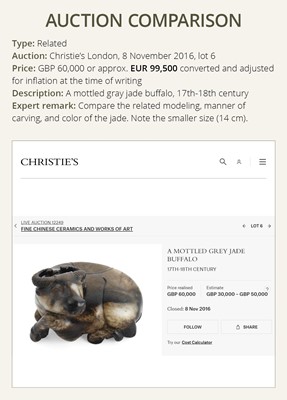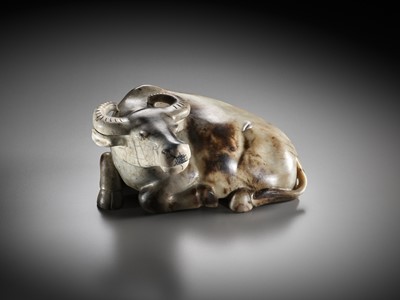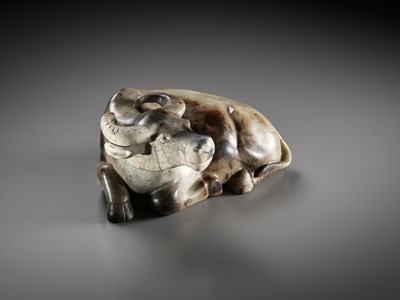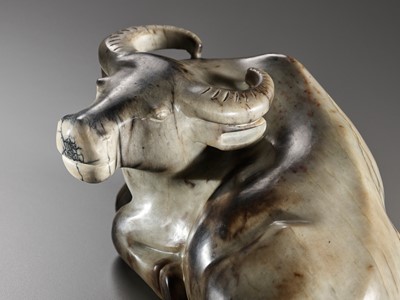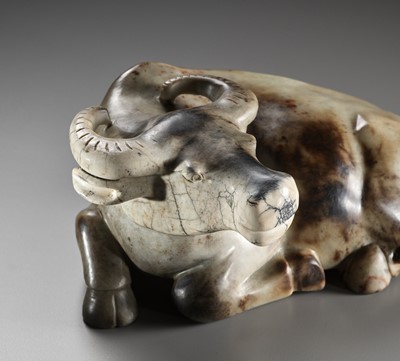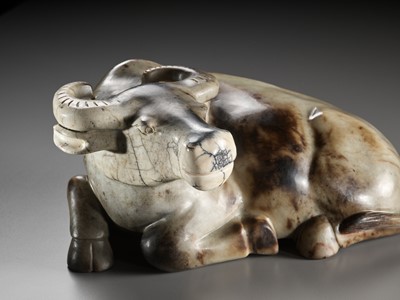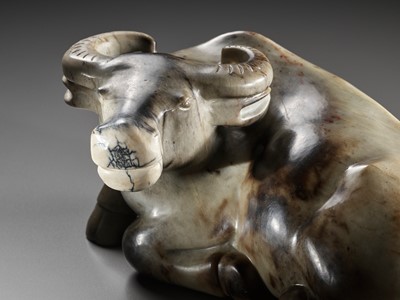11th Oct, 2023 11:00
THREE-DAY AUCTION - Fine Chinese Art / 中國藝術集珍 / Buddhism & Hinduism
25
A LARGE GRAY AND BLACK JADE FIGURE OF A WATER BUFFALO, LATE MING TO EARLY QING DYNASTY
明末清初大型灰黑色玉水牛
Sold for €7,150
including Buyer's Premium
Expert’s note: The present jade buffalo is one of the most 'lifelike' portrayals of this small group, the unusual coloring of the stone in different tones of buff and grey being reminiscent of the actual animals' skin. The rather eccentric choice of material, distinctly colored and veined, might best fit a late Ming date, while the masculine strength, elegance, and simplicity of the sculpting are in tune with stylistic principles of the Kangxi reign.
China, 17th to early 18th century. Powerfully carved in a recumbent pose, the right foreleg bent with the knee raised, the other legs tucked underneath the stout muscular body, the neatly incised tail flung to the left, the head turned in a position emphasizing the beast’s humped back. Its strong appearance contrasting with the calm, docile expression of its proud face, marked by almond-shaped eyes with incised pupils, and further detailed with an impressive pair of horns curving exactly parallel to the funnel-shaped ears. The smoothly polished, opaque stone is of a fine gray tone with black and russet shadings and veins, smokey and cloudy inclusions, the face and horns with partly calcified areas of ‘chicken bone’. Excellent polish, resulting in an unctuous surface feel overall.
Provenance: Rare Art, Inc., New York, USA, 1973. A private collection in the United States, acquired from the above and thence by descent. A copy of the original invoice from Rare Art, dated 30 May 1973, stating a purchase price for the present lot of USD 6,400 or approx. EUR 40,500 (converted and adjusted for inflation at the time of writing), accompanies this lot. The base with an old label from Rare Art stating the original listing price for the present lot of USD 8,000 or approx. EUR 50,500 (converted and adjusted for inflation at the time of writing).
Condition: Very good condition with expected ancient wear, few small nicks here and there, the stone with natural inclusions and fissures, some of which have developed into small hairline cracks.
Weight: 4,747 g
Dimensions: Length 23.5 cm
Please click here to read the full description
Jade buffalo, like this superbly carved example, have traditionally been greatly prized in China, where the animal is associated with strength, prosperity and tranquility. The ox or buffalo is one of the twelve horary animals representing one of the twelve branches of the Chinese calendrical system. Buffalo are also associated with farming and the production of food. The poetic view of the buffalo resonated with Chan Buddhists and Daoists alike, suggesting retreat into a tranquil rural life away from the cities and the responsibilities of public office.
The popularity of these creatures has an ancient source, since the legendary Emperor Yu of the Xia dynasty (c. 2100-1600 BC) is said to have cast an iron ox or buffalo to subdue the floods. This theme was taken up by the Qianlong Emperor (1736-95), when in 1755 he had a large bronze ox cast and placed looking out over Kunming Lake at the Summer Palace. On the animal's back was cast an 80-character essay in seal script referring to Yu's casting of the iron buffalo to control the floods. The mythological and practical auspiciousness of buffalo ensured that they were included among animal figures from early times, and by the period of the late Ming into the early Qing dynasty, a group of large finely carved jade figures was being produced. These buffalo were clearly treasured by the Imperial family since several of the extant examples are known to have come from the Summer Palace in 1860.
Literature comparison:
Compare a related gray and black jade buffalo from the Somerset de Chair and Mrs. Parsons collections, at Sotheby’s London, 18 July 1952, lot 50, and again, 9 June 2004, lot 151. Compare a related gray and black jade buffalo from the collection of Lord Gladwyn, illustrated by Jessica Rawson, Chinese Jade from the Neolithic to the Qing, British Museum, London, 1995, pl. 26:19, where the author notes that the buffalo is “said to have come from the Summer Palace, Beijing during the China War of 1860.” The provenance for the British Museum buffalo is further detailed in the footnote to lot 11 in Sotheby's London, 15 December 1987, noting that the British Museum jade buffalo was ... looted from the Summer Palace, Peking in 1860 and rescued on the troop ship from a soldier who was attempting to break it up for easier concealment on coming ashore...'.
Auction result comparison:
Type: Related
Auction: Sotheby’s Hong Kong, 7 April 2010, lot 1909
Price: HKD 7,820,000 or approx. EUR 1,302,000 converted and adjusted for inflation at the time of writing
Description: A rare large black and gray jade water buffalo, early Qing dynasty
Expert remark: Compare the related modeling with similar pose, features, and expression, manner of carving, and color of the jade with similar shadings of gray and black (albeit lacking the areas of chicken-bone). Note the tuft of hair on the buffalo’s forehead.
Auction result comparison:
Type: Related
Auction: Christie’s London, 8 November 2016, lot 6
Price: GBP 60,000 or approx. EUR 99,500 converted and adjusted for inflation at the time of writing
Description: A mottled gray jade buffalo, 17th-18th century
Expert remark: Compare the related modeling, manner of carving, and color of the jade. Note the smaller size (14 cm).
点此阅读中文翻译 (Chinese Translation)
明末清初大型灰黑色玉水牛
中國, 十七至十八世紀初。水牛呈臥姿,右前腿彎曲,膝蓋抬起,其他三腿夾在强健有力的身體下方,尾巴向左甩動,頭部微轉。面部平靜,目光溫順,牛角彎曲。表面光滑,不透明玉石呈灰色調,帶有黑色和赤褐色的紋理、褐色和絮狀內含物,面部和角上有部分鈣化的“雞骨”區域。整體光滑瑩潤。
專家注釋:這件玉水牛雕刻栩栩如生,玉石不同色調的淺黃色和灰色很像真正的動物皮膚。玉石色彩和紋理鮮明,可能來自明末時期,而雕刻的陽剛力量、優雅和簡潔則符合康熙時期的風格。
來源:美國紐約Rare Art, Inc.藝廊,1973年;美國私人收藏,購於上述藝廊,保存至今。隨附一份1973年5月30日Rare Art藝廊出具的發票副本一份,可見當時的售價為USD 6,400 或EUR 40,500 (根據通貨膨脹)。底部有藝廊原始標籤,可見原價為USD 8,000 或 EUR 50,500 (根據通貨膨脹)。
品相:狀況極好,有磨損,大面積小刻痕,玉石有天然內沁和裂縫,其中一些已經發展成細小的裂紋。
重量:4,747 g
尺寸:長23.5 厘米
文獻比較:
比較一件相近的灰黑色玉水牛,來自 Somerset de Chair and Mrs. Parsons collections,見倫敦蘇富比,1952年7月18日,lot 50,以及2004年6月9日,lot 151。比較一件相近的灰黑色玉水牛,來自Lord Gladwyn收藏,見Jessica Rawson,《Chinese Jade from the Neolithic to the Qing》,大英博物館,倫敦,1995年,圖26:19;作者提到:「一些是1860年英法聯軍時由圓明園帶出來的。」大英博物館的水牛曾售於倫敦蘇富比1987 年12 月15 日lot 11 號,在拍品註腳中有進一步詳細說明,此玉水牛……於1860 年從北京圓明園被盜,並在運兵船上一名士兵試圖將其拆開,以便在上岸時更容易隱藏……”。
拍賣結果比較:
形制:相近
拍賣:香港蘇富比,2010年4月7日,lot 1909
價格:HKD 7,820,000(相當於今日EUR 1,302,000)
描述:清初灰黑玉水牛
專家評論:比較相近的姿勢、特徵、表情、雕刻風格,以及玉石顏色具有相似的灰色和黑色陰影(儘管缺少雞骨玉色區域)。請注意水牛額頭上的一簇毛。
拍賣結果比較:
形制:相近
拍賣:倫敦佳士得,2016年11月8日,lot 6
價格:GBP 60,000(相當於今日EUR 99,500)
描述:十七至十八世紀灰玉水牛
專家評論:比較相近的模型、雕刻風格,以及玉石顏色。請注意尺寸較小 (14 釐米)。
Expert’s note: The present jade buffalo is one of the most 'lifelike' portrayals of this small group, the unusual coloring of the stone in different tones of buff and grey being reminiscent of the actual animals' skin. The rather eccentric choice of material, distinctly colored and veined, might best fit a late Ming date, while the masculine strength, elegance, and simplicity of the sculpting are in tune with stylistic principles of the Kangxi reign.
China, 17th to early 18th century. Powerfully carved in a recumbent pose, the right foreleg bent with the knee raised, the other legs tucked underneath the stout muscular body, the neatly incised tail flung to the left, the head turned in a position emphasizing the beast’s humped back. Its strong appearance contrasting with the calm, docile expression of its proud face, marked by almond-shaped eyes with incised pupils, and further detailed with an impressive pair of horns curving exactly parallel to the funnel-shaped ears. The smoothly polished, opaque stone is of a fine gray tone with black and russet shadings and veins, smokey and cloudy inclusions, the face and horns with partly calcified areas of ‘chicken bone’. Excellent polish, resulting in an unctuous surface feel overall.
Provenance: Rare Art, Inc., New York, USA, 1973. A private collection in the United States, acquired from the above and thence by descent. A copy of the original invoice from Rare Art, dated 30 May 1973, stating a purchase price for the present lot of USD 6,400 or approx. EUR 40,500 (converted and adjusted for inflation at the time of writing), accompanies this lot. The base with an old label from Rare Art stating the original listing price for the present lot of USD 8,000 or approx. EUR 50,500 (converted and adjusted for inflation at the time of writing).
Condition: Very good condition with expected ancient wear, few small nicks here and there, the stone with natural inclusions and fissures, some of which have developed into small hairline cracks.
Weight: 4,747 g
Dimensions: Length 23.5 cm
Please click here to read the full description
Jade buffalo, like this superbly carved example, have traditionally been greatly prized in China, where the animal is associated with strength, prosperity and tranquility. The ox or buffalo is one of the twelve horary animals representing one of the twelve branches of the Chinese calendrical system. Buffalo are also associated with farming and the production of food. The poetic view of the buffalo resonated with Chan Buddhists and Daoists alike, suggesting retreat into a tranquil rural life away from the cities and the responsibilities of public office.
The popularity of these creatures has an ancient source, since the legendary Emperor Yu of the Xia dynasty (c. 2100-1600 BC) is said to have cast an iron ox or buffalo to subdue the floods. This theme was taken up by the Qianlong Emperor (1736-95), when in 1755 he had a large bronze ox cast and placed looking out over Kunming Lake at the Summer Palace. On the animal's back was cast an 80-character essay in seal script referring to Yu's casting of the iron buffalo to control the floods. The mythological and practical auspiciousness of buffalo ensured that they were included among animal figures from early times, and by the period of the late Ming into the early Qing dynasty, a group of large finely carved jade figures was being produced. These buffalo were clearly treasured by the Imperial family since several of the extant examples are known to have come from the Summer Palace in 1860.
Literature comparison:
Compare a related gray and black jade buffalo from the Somerset de Chair and Mrs. Parsons collections, at Sotheby’s London, 18 July 1952, lot 50, and again, 9 June 2004, lot 151. Compare a related gray and black jade buffalo from the collection of Lord Gladwyn, illustrated by Jessica Rawson, Chinese Jade from the Neolithic to the Qing, British Museum, London, 1995, pl. 26:19, where the author notes that the buffalo is “said to have come from the Summer Palace, Beijing during the China War of 1860.” The provenance for the British Museum buffalo is further detailed in the footnote to lot 11 in Sotheby's London, 15 December 1987, noting that the British Museum jade buffalo was ... looted from the Summer Palace, Peking in 1860 and rescued on the troop ship from a soldier who was attempting to break it up for easier concealment on coming ashore...'.
Auction result comparison:
Type: Related
Auction: Sotheby’s Hong Kong, 7 April 2010, lot 1909
Price: HKD 7,820,000 or approx. EUR 1,302,000 converted and adjusted for inflation at the time of writing
Description: A rare large black and gray jade water buffalo, early Qing dynasty
Expert remark: Compare the related modeling with similar pose, features, and expression, manner of carving, and color of the jade with similar shadings of gray and black (albeit lacking the areas of chicken-bone). Note the tuft of hair on the buffalo’s forehead.
Auction result comparison:
Type: Related
Auction: Christie’s London, 8 November 2016, lot 6
Price: GBP 60,000 or approx. EUR 99,500 converted and adjusted for inflation at the time of writing
Description: A mottled gray jade buffalo, 17th-18th century
Expert remark: Compare the related modeling, manner of carving, and color of the jade. Note the smaller size (14 cm).
点此阅读中文翻译 (Chinese Translation)
明末清初大型灰黑色玉水牛
中國, 十七至十八世紀初。水牛呈臥姿,右前腿彎曲,膝蓋抬起,其他三腿夾在强健有力的身體下方,尾巴向左甩動,頭部微轉。面部平靜,目光溫順,牛角彎曲。表面光滑,不透明玉石呈灰色調,帶有黑色和赤褐色的紋理、褐色和絮狀內含物,面部和角上有部分鈣化的“雞骨”區域。整體光滑瑩潤。
專家注釋:這件玉水牛雕刻栩栩如生,玉石不同色調的淺黃色和灰色很像真正的動物皮膚。玉石色彩和紋理鮮明,可能來自明末時期,而雕刻的陽剛力量、優雅和簡潔則符合康熙時期的風格。
來源:美國紐約Rare Art, Inc.藝廊,1973年;美國私人收藏,購於上述藝廊,保存至今。隨附一份1973年5月30日Rare Art藝廊出具的發票副本一份,可見當時的售價為USD 6,400 或EUR 40,500 (根據通貨膨脹)。底部有藝廊原始標籤,可見原價為USD 8,000 或 EUR 50,500 (根據通貨膨脹)。
品相:狀況極好,有磨損,大面積小刻痕,玉石有天然內沁和裂縫,其中一些已經發展成細小的裂紋。
重量:4,747 g
尺寸:長23.5 厘米
文獻比較:
比較一件相近的灰黑色玉水牛,來自 Somerset de Chair and Mrs. Parsons collections,見倫敦蘇富比,1952年7月18日,lot 50,以及2004年6月9日,lot 151。比較一件相近的灰黑色玉水牛,來自Lord Gladwyn收藏,見Jessica Rawson,《Chinese Jade from the Neolithic to the Qing》,大英博物館,倫敦,1995年,圖26:19;作者提到:「一些是1860年英法聯軍時由圓明園帶出來的。」大英博物館的水牛曾售於倫敦蘇富比1987 年12 月15 日lot 11 號,在拍品註腳中有進一步詳細說明,此玉水牛……於1860 年從北京圓明園被盜,並在運兵船上一名士兵試圖將其拆開,以便在上岸時更容易隱藏……”。
拍賣結果比較:
形制:相近
拍賣:香港蘇富比,2010年4月7日,lot 1909
價格:HKD 7,820,000(相當於今日EUR 1,302,000)
描述:清初灰黑玉水牛
專家評論:比較相近的姿勢、特徵、表情、雕刻風格,以及玉石顏色具有相似的灰色和黑色陰影(儘管缺少雞骨玉色區域)。請注意水牛額頭上的一簇毛。
拍賣結果比較:
形制:相近
拍賣:倫敦佳士得,2016年11月8日,lot 6
價格:GBP 60,000(相當於今日EUR 99,500)
描述:十七至十八世紀灰玉水牛
專家評論:比較相近的模型、雕刻風格,以及玉石顏色。請注意尺寸較小 (14 釐米)。
Zacke Live Online Bidding
Our online bidding platform makes it easier than ever to bid in our auctions! When you bid through our website, you can take advantage of our premium buyer's terms without incurring any additional online bidding surcharges.
To bid live online, you'll need to create an online account. Once your account is created and your identity is verified, you can register to bid in an auction up to 12 hours before the auction begins.
Intended Spend and Bid Limits
When you register to bid in an online auction, you will need to share your intended maximum spending budget for the auction. We will then review your intended spend and set a bid limit for you. Once you have pre-registered for a live online auction, you can see your intended spend and bid limit by going to 'Account Settings' and clicking on 'Live Bidding Registrations'.
Your bid limit will be the maximum amount you can bid during the auction. Your bid limit is for the hammer price and is not affected by the buyer’s premium and VAT. For example, if you have a bid limit of €1,000 and place two winning bids for €300 and €200, then you will only be able to bid €500 for the rest of the auction. If you try to place a bid that is higher than €500, you will not be able to do so.
Online Absentee and Telephone Bids
You can now leave absentee and telephone bids on our website!
Absentee Bidding
Once you've created an account and your identity is verified, you can leave your absentee bid directly on the lot page. We will contact you when your bids have been confirmed.
Telephone Bidding
Once you've created an account and your identity is verified, you can leave telephone bids online. We will contact you when your bids have been confirmed.
Classic Absentee and Telephone Bidding Form
You can still submit absentee and telephone bids by email or fax if you prefer. Simply fill out the Absentee Bidding/Telephone bidding form and return it to us by email at office@zacke.at or by fax at +43 (1) 532 04 52 20. You can download the PDF from our Upcoming Auctions page.
How-To Guides
How to Create Your Personal Zacke Account
How to Register to Bid on Zacke Live
How to Leave Absentee Bids Online
How to Leave Telephone Bids Online
中文版本的操作指南
创建新账号
注册Zacke Live在线直播竞拍(免平台费)
缺席投标和电话投标
Third-Party Bidding
We partner with best-in-class third-party partners to make it easy for you to bid online in the channel of your choice. Please note that if you bid with one of our third-party online partners, then there will be a live bidding surcharge on top of your final purchase price. You can find all of our fees here. Here's a full list of our third-party partners:
- 51 Bid Live
- EpaiLive
- ArtFoxLive
- Invaluable
- LiveAuctioneers
- the-saleroom
- lot-tissimo
- Drouot
Please note that we place different auctions on different platforms. For example, in general, we only place Chinese art auctions on 51 Bid Live.
Bidding in Person
You must register to bid in person and will be assigned a paddle at the auction. Please contact us at office@zacke.at or +43 (1) 532 04 52 for the latest local health and safety guidelines.
